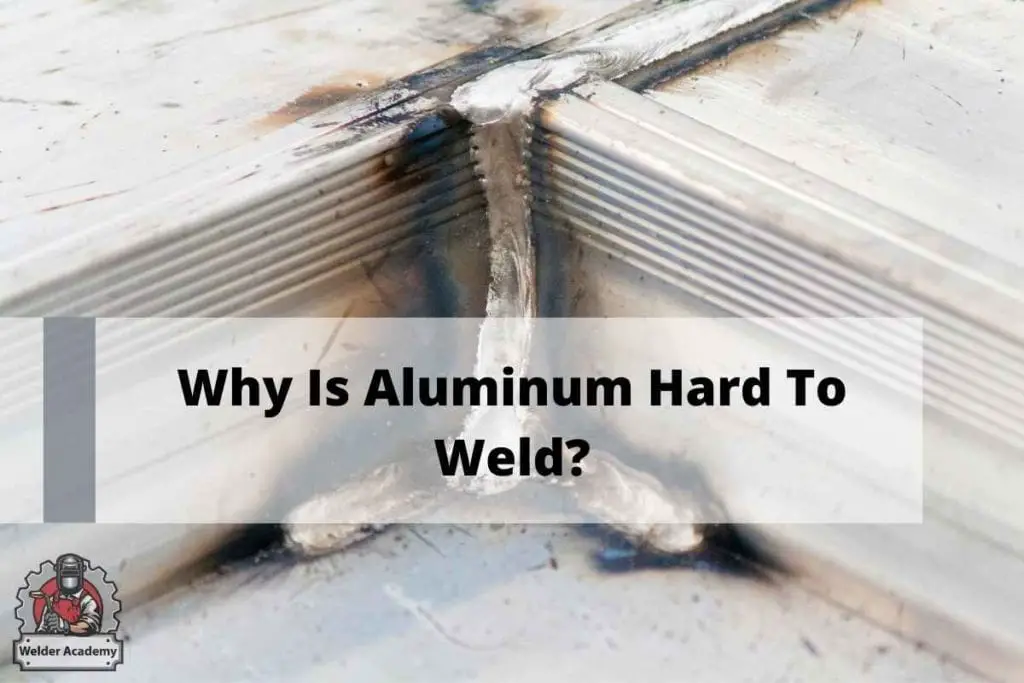Aluminum is a metal that is suitable for a wide variety of projects. It looks great and is very resistant to natural impacts. And the nicest thing about it is how lightweight it is. Despite all these benefits, there’s one thing that welders cannot help but wonder about, and that is: why is aluminum hard to weld? Let’s look into it.
It is a soft metal and it has an extremely reactive and tough layer of oxidation insulating it. Secondly, the metal has a low melting point and high thermal conductivity. As a result, you can understand your progression when welding.

If you have difficulties while welding aluminum, read the following discussion to understand why it happens and what you can do to make it better.
Why Is Aluminum Hard To Weld?
So why is an aluminum hard to weld? There are several reasons for this, as well as several points to consider. However, this doesn’t mean you have to be a highly qualified professional to weld aluminum. All it takes is having the right knowledge.
Lack Of Visual Cues
To make things easier, let’s compare steel and aluminum. The reason people say aluminum is harder to weld is that steel is relatively easier to weld. The convenience of working with steel is evident during the welding process.
Application of heat changes the color of steel. It then starts to glow and finally starts to melt. These signs can guide the welder through the process of adjusting the heat or adding materials.
On the other hand, aluminum doesn’t work like that. There are less prominent visual indicators when you are welding aluminum. The metal just keeps getting brighter with heat.
There’s no other clue. Therefore, someone with less experience isn’t able to tell at which stage of the welding process they are in.
Oxide-layer And Low Melting Point
Besides the lack of visual indicators, there is the matter of oxidation and the low melting point. If you want to get better at welding aluminum, you have to understand this.
Let’s consider oxidation first. When aluminum comes into contact with moisture and air, a fine layer of aluminum oxide is created on it. The layer is about four nanometres thick. It is an extremely tough layer with a high melting point, which protects the layer from any kind of environmental corrosion.
But as was mentioned earlier, aluminum itself has a low melting point. Around 660 degrees Celsius. While Aluminum Oxide burns at 2072 degrees Celsius,
So, when you start welding, you have to apply high heat to melt the layer of oxidation. But while you do that, the underlying pure aluminum, which has a much lower melting point, will start to melt.
As a result, you experience an irregularity in the overall welding process and do not get your desired result.
Impurities And Gas Absorption
Another problem is sensitivity. Aluminum is more sensitive to impurities like air and dirt than other metals. As a result, it easily taints during the welding process and creates problems in the finished product. This is why thorough cleaning before welding is necessary.
The absorption of hydrogen gas is also an important reason for the difficulty of welding aluminum. When the metal is heated up, it starts absorbing hydrogen at an increasing rate. But when the metal starts to cool down, the gas starts to escape.
Consequently, there is the formation of bubbles inside the solidified metal. These bubbles cause porousness in the welding. As a result, the end product of your welding is weak and susceptible to breaking.
How To Weld Aluminum Effectively?
From the above discussion, it is easy to gather why aluminum is hard to weld. If you can deal with these problems, then welding aluminum will become easy and you will finish many wonderful projects. So let’s see how to do it.
Proper preparation
The first and foremost step is preparing the metal properly before welding. You already know how the layer of oxidation hampers the welding process.
Plus, dirt, dust, or other minor impurities can significantly affect your work. Here, cleaning the metal can be the solution.
Use an oxide remover to remove the oxidation layer. You can also use a stainless-steel brush to strip the insulation.
If you use the brush, make sure that you use it only with aluminum and not with other materials. Otherwise, there will be a chance of contamination. After that, if you don’t use the metal immediately, store it properly in a dry place.
You can use a cellophane sheet or some other method to ensure airtightness and prevent moisture. Otherwise, a layer of oxidation will again fall on the metal.
Shielding Gas And Metal Fillers
To prevent the absorption of hydrogen and subsequent porousness, you need to use a shielding gas. The most commonly used shielding gasses are helium and argon.
Keep in mind that helium has a high ionization potential. So, when you use it for shielding, apply a higher voltage.
The correct choice of metal fillers is also important to effectively deal with porousness. The fillers should match your base alloys.
There are four commonly used fillers for aluminum alloys. Copper alloys, silicon alloys, magnesium alloys, and 99 percent aluminum.
Grinding Disc
Grinding discs is another consideration when you are working with a sensitive metal like aluminum. If you use the same grinding disc on aluminum that you use to weld steel, you will run into several problems.
First, the metal is softer and melts at much lower temperatures than steel. So, using the same disc that you use for steel will hamper your welding. Plus, the melted aluminum would also gum up the disc, which would result in destroying your tools.
And secondly, when you use the same disc you previously used on steel, it will contaminate the sensitive aluminum. So, you should be careful not to keep your aluminum welding tools separate.
Lastly, aluminum doesn’t give off a shower of sparks like steel when you grind it. So, if you are more used to welding steel, you might not clearly understand how much you are grinding down on the aluminum. The solution here is to continue working on the metal and gain experience.
When working with aluminum, the grinding disc should be made from a similar soft metal. For example, brass, copper, or aluminum.
Common Aluminum Welding Techniques
So far, you’ve learned about the causes of difficulty in welding aluminum and how to prepare the metal to deal with them. Now let’s have a look at some of the welding techniques professionals use to get the best results from their work.
Most welders use the weaving technique when working with steel. But as aluminum has more thermal conductivity, this technique is not best for the metal.
Instead, use the stringer bead technique. This will result in proper heat penetration and subsequent fusion.
When welding aluminum, you will want to use a “push” technique. This helps to reduce the gas absorption and resulting porosity.
The welder uses a “pull” technique to achieve a more pleasant and aesthetic exterior to the weld. But in the case of aluminum, this will result in the entrapment of impurities in the material.
The visual indicators used in aluminum welding are not adequate to aid in the process. So, to amplify whatever visual cues are present, you need to wear a helmet with a high-quality lens.
On the other hand, using a blurry or worn-out lens will make your work more difficult than it already is.
Conclusion
Hopefully, the above discussion provides some solution to the query: why is aluminum hard to weld? Always thoroughly clean the metal before you start working. Keep your aluminum welding tools separate from the other machines. And lastly, be sure to use good-quality personal gear.
